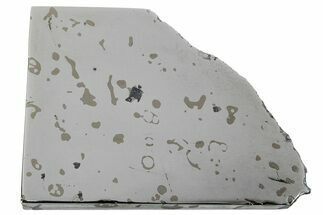This Specimen has been sold.
1.55" Sikhote-Alin Iron Meteorite Shrapnel (41.4 g) - Russia
This is a 1.55" wide (41.4 grams) shrapnel piece of the iron-nickel (coarse octahedrite) Sikhote-Alin meteor, collected from the strewn field in the Sikhote-Alin Mountains of Russia.
The Sikhote-Alin Meteorite
The Sihkote-Alin meteorite is an iron meteorite (IIAB, coarse octahedrite) that fell in eastern Siberia on February 12th, 1947. At 10:38 AM that day, this meteor, moving about 50,400 kilometers per hour, pierced the atmosphere and made impact in the thick forest of the Sikhote-Alin Mountains. The bright flash and loud boom were witnessed up to 300 kilometers away from the site of impact. This fall produced 106 impact holes, some up to 28 meters in diameter, over an area of 100 by 660 meters. Many fragments weighing up to 300 kilograms have been recovered. Prior to entering the atmosphere, the meteoroid likely had a mass of about 100,000 kilograms.
The Sikhote-Alin site contains two distinct types of material. One type are individual specimens, usually found with fusion crust, ablation signs, and distinct thumbprint-like regmaglypts on their exteriors. These likely broke only a few kilometers over the ground, since they had time to form regmaglypts. The other type are shrapnel and sharp-edged, irregularly shaped fragments, found all around the impact site and even embedded in surrounding trees. These fragments were likely formed by the shock of hitting frozen ground.
To date, over 23,000 kilograms of post-atmospheric mass have been recovered.
The Sihkote-Alin meteorite is an iron meteorite (IIAB, coarse octahedrite) that fell in eastern Siberia on February 12th, 1947. At 10:38 AM that day, this meteor, moving about 50,400 kilometers per hour, pierced the atmosphere and made impact in the thick forest of the Sikhote-Alin Mountains. The bright flash and loud boom were witnessed up to 300 kilometers away from the site of impact. This fall produced 106 impact holes, some up to 28 meters in diameter, over an area of 100 by 660 meters. Many fragments weighing up to 300 kilograms have been recovered. Prior to entering the atmosphere, the meteoroid likely had a mass of about 100,000 kilograms.
The Sikhote-Alin site contains two distinct types of material. One type are individual specimens, usually found with fusion crust, ablation signs, and distinct thumbprint-like regmaglypts on their exteriors. These likely broke only a few kilometers over the ground, since they had time to form regmaglypts. The other type are shrapnel and sharp-edged, irregularly shaped fragments, found all around the impact site and even embedded in surrounding trees. These fragments were likely formed by the shock of hitting frozen ground.
To date, over 23,000 kilograms of post-atmospheric mass have been recovered.
About Iron Meteorites
Iron type meteorites are composed primarily of iron and nickel, and are the remnants of differential cores torn apart at the beginning of the solar system. These metallic meteorites are often the easiest to identify after millions of years post-impact because they are quite different from terrestrial material, especially when it comes to their mass-to-surface area ratio. They are exceptionally heavy for their size since iron is a high-density metal: this is also why the Earth's core is nickel-iron. As planets form, the densest metals form gravitational centers, bringing more and more material into their gravitational pull. In the solar system's rocky planets, these dense materials are most often nickel and iron.
Most iron meteorites have distinctive, geometric patterns called Widmanstätten patterns, which become visible when the meteorite is cut and acid etched. These patterns are criss-crossing bands of the iron-nickel alloys kamacite and taenite that slowly crystalized as the core of the meteorites' parent bodies slowly cooled. Such large alloy crystallizations for mover millions of years and do not occur naturally on Earth, further proving that iron meteorites come from extraterrestrial bodies.
Iron type meteorites are composed primarily of iron and nickel, and are the remnants of differential cores torn apart at the beginning of the solar system. These metallic meteorites are often the easiest to identify after millions of years post-impact because they are quite different from terrestrial material, especially when it comes to their mass-to-surface area ratio. They are exceptionally heavy for their size since iron is a high-density metal: this is also why the Earth's core is nickel-iron. As planets form, the densest metals form gravitational centers, bringing more and more material into their gravitational pull. In the solar system's rocky planets, these dense materials are most often nickel and iron.
Most iron meteorites have distinctive, geometric patterns called Widmanstätten patterns, which become visible when the meteorite is cut and acid etched. These patterns are criss-crossing bands of the iron-nickel alloys kamacite and taenite that slowly crystalized as the core of the meteorites' parent bodies slowly cooled. Such large alloy crystallizations for mover millions of years and do not occur naturally on Earth, further proving that iron meteorites come from extraterrestrial bodies.
TYPE
Iron (IIAB)
LOCATION
Sikhote-Alin Mountains, Southeastern Russia
SIZE
1.55 x 1 x .6", Weight: 41.4 grams
CATEGORY
SUB CATEGORY
ITEM
#243165
 Reviews
Reviews












